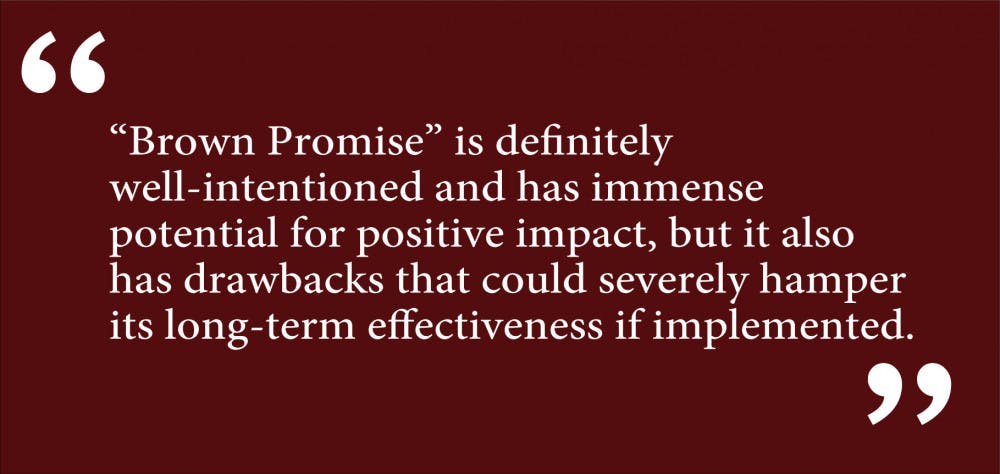“Don’t make a promise you can’t keep,” my mother would tell me growing up. I learned the power and strength of the word “promise” at a young age. Maybe that’s why Brown has decided to call its new initiative to eliminate student loans for its undergraduates “Brown Promise.” Maybe President Christina Paxson P’19 and the administration deliberately chose the name of the campaign to highlight just how strong this new commitment to making Brown as affordable as possible really is. But the thing about promises is that they’re supposed to be unconditional guarantees — “Brown Promise,” given its funding structure, doesn’t exactly fit this description. On the whole, “Brown Promise” is definitely well-intentioned and has immense potential for positive impact, but it also has drawbacks that could severely hamper its long-term effectiveness if implemented.
Students and alums of all socioeconomic backgrounds should care about the initiative because it would immediately benefit 883 students — all students on loans who are not seniors — for the next academic school year, The Herald previously reported. The Brown experience for these students could be altered for the better, relieving them of the stress of post-graduation debt. When students are freed from the weight of loans on their shoulders, it becomes so much easier to enjoy their time at Brown doing what they love. This kind of reassurance does wonders for a student’s ability to confidently navigate their Brown experience and put their best foot forward in all of their endeavors.
Making Brown affordable by eliminating the burden of loans also makes Brown a more diverse campus that better attracts the best applicants. Consider this startling fact: More Brown students come from the top 1 percent than from the entire bottom 60 percent. Now put this reality in conversation with Brown’s commitment to building a diverse community. In the Diversity and Inclusion Action Plan, the University acknowledges that it has “traditionally failed to include fully people of all … socioeconomic classes.” To remedy this, Brown has committed itself to becoming a more diverse and inclusive institution. Brown Promise is a good way to start to fulfill this commitment, and make the University more affordable for incoming students for years to come. When financial aid packages become less of a concern, prospective students are emboldened to apply knowing that their dream come true isn’t, quite literally, coming at the expense of their family. After all, Brown becomes better by picking the students who best fit its values and reflect its commitment to inclusivity, not simply admitting those students who are most able to pay. And to be clear, increasing the proportion of low-income students does not mean poorer academic performance or job placement after graduation: A recent New York Times investigation found that low-income students who attend highly selective institutions fare just as well as their wealthier peers. The added diversity fostered by the initiative ultimately culminates in Brown becoming a better school — a school that removes barriers to admission that are not related to a student’s merit or potential, ensuring that Brown receives the best applicants possible. “Brown Promise” aids immensely in this effort.
Of course, the initiative is not faultless. It’s more than worth mentioning that this entire initiative is predicated on whether or not the University can raise $30 million by December. This condition runs a bit contrary to the idea of a “promise.” In fact, how can you promise the elimination of student loans from financial aid packages when the necessary funding, as of yet, is not a reality? Right now, we’re millions of dollars away from fulfilling this “promise” and it doesn’t seem fair to elaborately promote this initiative when there’s a chance that it may not even come to fruition.
Further, “Brown Promise” alone can’t ensure greater diversity in the Brown student body. Owen Colby ’20 wrote on Sept. 22 about the shortcomings of this initiative, citing antiquated admission practices as one of the major inhibitors that would keep the initiative’s goal of socioeconomic diversity from being fulfilled. The college admission process, broadly speaking, already disadvantages applicants who could make an institution more socioeconomically diverse. For example, while fee waivers are helpful, they don’t help an applicant who could only afford to take the SAT or ACT once and didn’t have the resources to devote as much time to test preparation as their peers. Schools like George Washington University and nearby Providence College have implemented test-optional policies that don’t make standardized testing mandatory, effectively removing an economic barrier for those applicants whose capabilities simply can’t be reflected by their results on one test. Brown should consider adopting some variation of these policies to complement “Brown Promise.”
It is true that “Brown Promise” doesn’t tackle the hurdles presented by the admission process and the entirety of the initiative is dependent on fundraising $30 million by December. It is also true that in spite of all of the potential good that may be in store, nothing has been guaranteed as of now; Brown has yet to make good on its promise. Any and all doubts about this initiative are valid. But I still find it worthwhile to get excited about Brown’s early efforts to reform its financial aid practices. “Brown Promise” is a crucial step in the right direction, toward not only helping students on financial aid, but also upholding the University’s commitment to creating an inclusive community that unites scholars of all needs and backgrounds.
Quentin Thomas ’21 can be reached at quentin_thomas@brown.edu. Please send responses to this opinion to letters@browndailyherald.com and other op-eds to opinions@browndailyherald.com.




